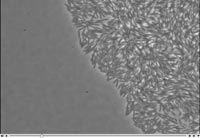Studies of cell traits nets big award for UW-Madison researcher
University of Wisconsin–Madison biochemist Doug Weibel may not be able to bend or shape cells any way he wants to — yet.
However, Weibel’s efforts to uncover the molecular choreography within the cell that governs their physical, chemical and physiological attributes — including shape, behavior and development — have earned the young scientist a prestigious Searle Scholar Award. The $300,000 award over three years was last conferred on a UW–Madison faculty member in 1997 when pharmacy professor Ben Shen was recognized.
View a Quicktime movie showing a population of swarming cells of Escherichia coli on an agar surface.
The award will support Weibel’s exploration of some of the fundamental mysteries of bacterial cells, work that promises to make them more amenable for study and manipulation in the interest of such things as the development of biofuels and new antibiotics.
"We work specifically on bacteria," says Weibel, who joined the UW–Madison faculty in 2006. "One of the things we’re really interested in is how bacteria sense their environment. For example, how can a cell sense if it’s on a surface or in a liquid?"
How cells respond to their environments, Weibel explains, is a complex mix of physical and chemical variables, and in the case of bacteria, those variables may vary from organism to organism. One critical problem Weibel’s group is addressing is why it is so difficult to tame most bacteria, making it impossible for many important microorganisms to be studied in the lab.
It is widely believed that more than 99 percent of the world’s microbes can’t be isolated and cultured using current methods. Weibel’s approach to the problem, which is interdisciplinary in the extreme and weaves chemistry, material science and engineering into the equation, involves developing new polymer structures that mimic the natural habitats of different classes of bacteria. By designing microenvironments in tune with different kinds of bacteria, it may be possible to bring them within reach of science, affording better opportunities to thwart pathogenic microbes or tame those that might be useful for converting biomass to sugars that can be used in biofuels.
Another thrust of the Weibel lab is helping to figure out why bacteria behave as they do. For example, is there such a thing as collective behavior in bacteria?
"We’re very interested in the question of how does collective behavior in populations of bacteria arise," Weibel says. "Emerging behavior is a property of a system you can’t predict from the sum of the individual components. The swarming of bacterial cells on surfaces is a fascinating example of what might be considered emergent or multicellular behavior."
Such issues are important, notes Weibel, as swarming behavior in bacteria can switch on genes that transform benign bacterial cells into pathogens. For instance, the bacterial films that form on catheters and other biomedical devices and expose patients to serious infection arise from a bacterium’s tendency to live and migrate collectively.
Weibel is also attempting to develop imaging techniques that will help science resolve how the internal scaffolding of cells, the cytoskeleton, is organized in space and time. That, in turn, could lead to new methods to alter the shape of cells.
"In bacteria, cell shape is typically conserved. A rod-shaped cell always produces a rod-shaped offspring and a sphere always produces spheres," according to Weibel. "But it’s possible to turn a rod-shaped bacterium into a cube or a right-handed coil. Or you can take a rod and engineer a kink in it. We want to understand how shape is connected to the underlying cytoskeleton and how this system controls the spatial and temporal location of other components in the cell."
Teasing out those secrets, he says, could help scientists develop novel antibiotics at a time when there is a critical need to replenish the antimicrobial armamentarium in response to germs that have evolved resistance to conventional antibiotics.





